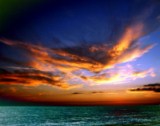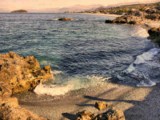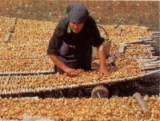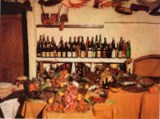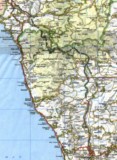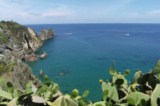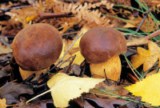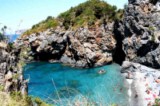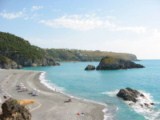|
THE RIVIERA DEI CEDRI - CALABRIA- SOUTH ITALY
THE RIVIERA TOWNS
TheTyrrhenian coast of the province of Cosenza, stretching as it does from Tortora to Paola, is bounded to the north by the river Noce which marks
the border between the regions of Lucania and Calabria for about six km,
to the south by the indented coast, and to the east by the coastal mountain
range named after the city of Paola and by a number of hills-the extreme
appendages of the Apennine range-of a dolomitic nature formed by limestone
and crystalline and schistose rock. The coastal line, which measures about
90 km in length forms a series of long broad sandy beaches alternating
with tiny, moon-shaped bays embedded between promontories jutting out into
the sea, with upland plains and overhanging rocks. Now and again the coastline
is interrupted by springs, torrents and rivers fed by rainfalls which are
abundant especially on the ridges, between October and March.
The sea with its reefs of rocks, the hills and overhanging cliffs, land terraces
and sandy gorges dug by the rainwater, rocks jutting out into and out of
the sea, mountains and multifarious hues of the luxuriant vegetation have
combined with the action of endogenous and exogenous energy over the ages,
making this into one of the most interesting stretches of the earth under
the most diverse respects; whether physical, geologic, economic, historic,
or artistic.
WHERE TO EAT - WHERE TO HAVE FUN - SPONSORS |
| |
|
| |
|
YOUR ADVERTISEMENT BANNER HERE |
Man settled in this area as early as the pre-historic age. Life and civilization
along this coast indeed date back to the Old Stone Age; Acheulian bifacial
hand axes left by homosapiens on the Rosaneto in Tortora date from
about one thousand and fifty thousand years ago, the cave named Grotta
della Madonna at Praia were used as early human dwellings, man lived
in the shelter-cave named Grotta del Romito, at Papasidero, for
a span of over a thousand years, and then switched over to hut-life in
the 7th century B.C. at Petrosa di Scalea, its historic centre a maze of
streets with arches, steps, and a splendid seafront below, also has the
Talao Grotto, where Palaeolithic remains have been found.
A straight road leads to Cirella, while on a rocky site slightly inland stand Grisolia and
MaierÓ', two small villages barely separated by a valley,
but before these on this same road the next main town is Santa Maria del
Cedro, hence the name "Riviera dei Cedri", where the main Citrus is grown
and picked which is used in making essences, liqueurs and candied fruit.
It graciously sits at the end of the Citrus plantations and olive groves.
Cirella marina is a restful spot in the middle of olive groves, just below the
ruins of the old village, further away from the water, where ruined churches
and buildings lie in total silence. Facing the sand and pebble beach, 4km
long and 40km wide, is a deserted rocky island, the delight of snorkellers
and those who love the characteristic Mediterranean vegetation. Calabria
has one of the least polluted expanses of sea for public bathing, according
to a recent study by the Ministry of Health. Diamante has a wider beach
with its crystal clear blue water and is well known for its 130 Murales
painted on the walls of its historical centre.
Belvedere, slightly further south, has another characteristic: a kind of clay, derived
from the calanques and fiumare, enabling potters to carry
on their old tradition. There is even a church completely decorated with
ceramics.
Sangineto, Cetraro, Acquappesa, Guardia, Fuscaldo and Paola make up the rest of the Riviera dei Cedri, all having splendid beaches, where the cooling presence of the Catena Costiera lying parallel to the sea, with its woodland and glades,
mitigates the summer heat. The coast stretches more or less unchanged with
a series of towns and villages, and fine sandy beaches.
The Riviera Towns

| PRAIA A MARE |
stands by a long sandy beach, opposite the mythical Island of Dino, where, as
the legend goes, Ulysses once landed and where you can find the
natural grottos of "The Lion" and the "Azure" Grotto. Praia a Mare
is the first inhabited resort that you meet along the Tyrrhenian
coast. Visit the Sanctuary of Saint Maria of the Grotto, which is
inside a natural grotto, reached by a long flight of steps,
containing a wooden statue of the Madonna and Child that dates back
to XIV century. Much of Praia's history is contained in this grotto
where many Palaeolithic, Neolithic and Roman articles have been
found. |
| AIETA |
whose origins are ancient, has developed around the recently restored Martirano
building, one of the most imperious and beautiful constructions in
Calabria. The historical centre of Aieta is characteristic for its
medieval architecture. Today, Aieta owes its fame to its
gastronomical traditions, and its arts and crafts, especially its
textile works and gastronomical delicatessen. |
| SCALEA |
with its medieval structures and characteristic houses, built almost one on
top of the other, is one of the few resorts on the Calabrian coast
to have an historical centre so well preserved with its Byzantine
churches, antique castle ruins, medieval buildings, and breathtaking
view of the coastline with its long beaches of dark volcanic sand,
and steep rocky inlets. Palaeolithic remains have been found in the
cavern under "Torre Talao" which was the sentinel tower built to
protect the town from invaders coming from sea. |
| PAPASIDERO |
a town in the
immediate Calabrian hinterland, where time seems to have stood still. Its
medieval character and antique traditions are kept alive in the every day way of
living of its inhabitants. Visit the church of Saint Mary to admire the
frescos.. or the "Grotto of Romito", in the locality of Avena, where a primitive
carving of an ox has been found on one of the Grotto's walls. This was set to be one of the
most ancient works of art performed by prehistoric man. A copy of it has been
reproduced and is now held in the National Museum of Reggio Calabria. |
| DIAMANTE & CIRELLA |
is a famous resort, known internationally for its 130 Murales, painted in the
historical centre by artists from all over Europe, and its promenade
in the form of a long terrace. Between Scalea and Diamante lies the
small resort of Cirella with its historical centre where traces of
its mythical past can be found. Cirella has been destroyed and
rebuilt from various dynasties in ancient past but is now one of the
most beautiful and characteristic little towns of the "Riviera dei
Cedri" and is part of Diamante. |
| VERBICARO |
is one of the most well-known areas, belonging to the "Montana Community" in the Tyrrhenian Cosentino region, for its wines, homemade salamis and authentic traditions. The social wine cellar has been
producing wine for quite some time and can enjoy from a few years the
classification of the wine that takes the name from the same town, as a DOC. The characteristic
procession, held to celebrate Good Friday is quite spectacular with its parade
of religious disciples who beat themselves in physical penitence, in remembrance
to the sacrifice of Jesus Christ. Visit the historical centre, full of medieval
architecture and the church of the Madonna of the Nevi, where Byzantine frescos
can be found. |
| PAOLA |
is the chief religious centre of Calabria with its Sanctuary of Saint Francis of Paola,
founder of the order of the "Minimi" friars. The sanctuary is built 2 kms from
the town centre of Paola and adjacent to the hermitage grotto, where the young
saint spent many years in hermitage and prayer. Visit the church in the
convent, with its cloisters and the area where the saint performed his
miracles. |
|



